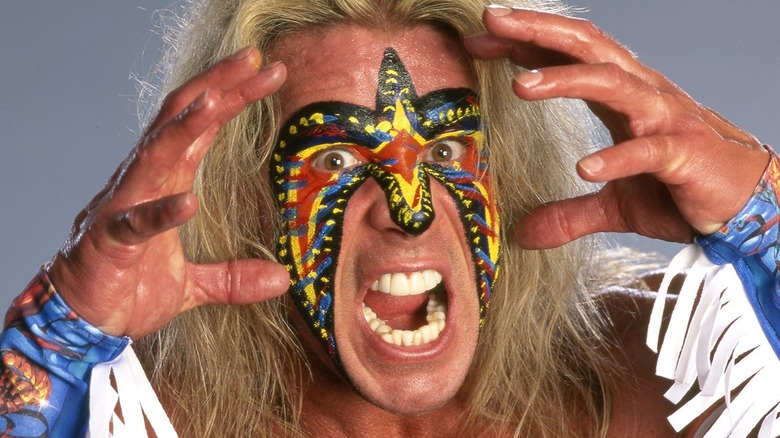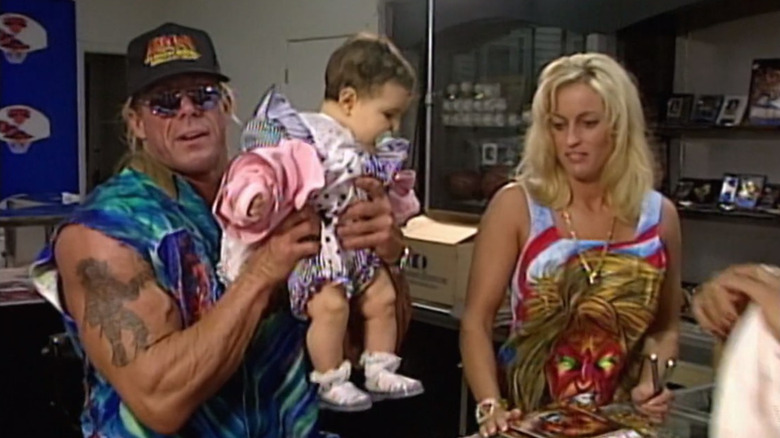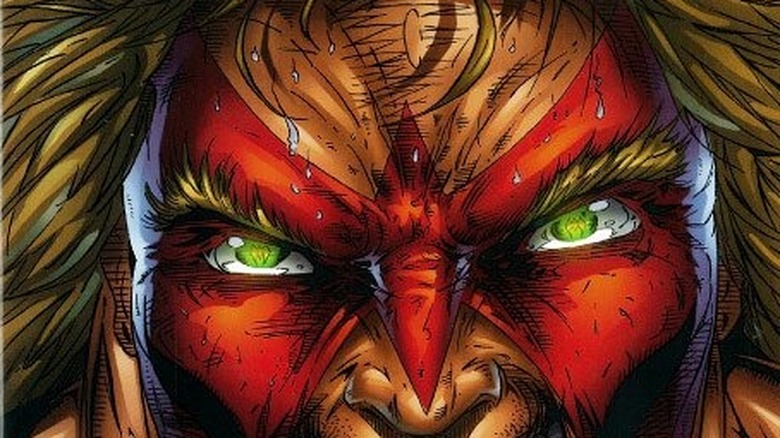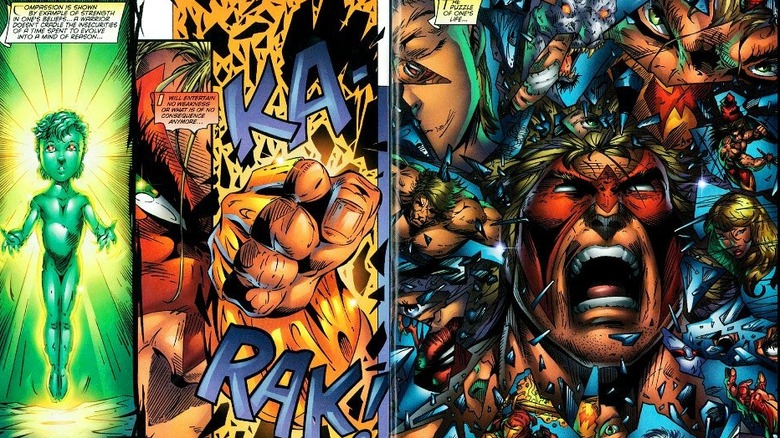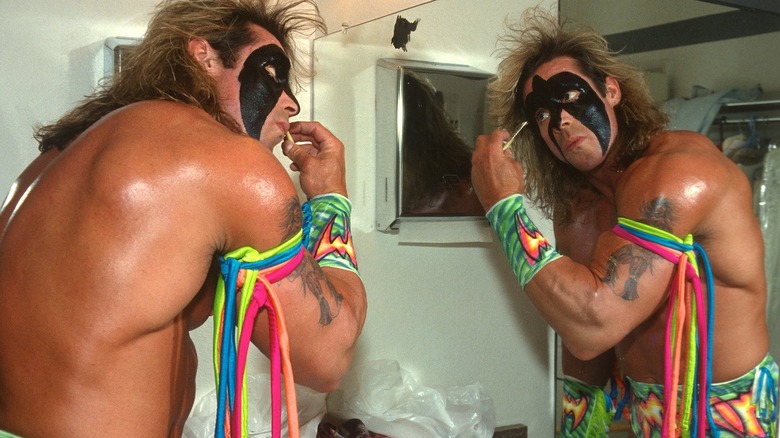The Ultimate Warrior Once Claimed His Failed Comic Books Were More Important To Him Than Wrestling
"The Ultimate Warrior is back!" said Vince McMahon on commentary after The Ultimate Warrior defeated Hunter Hearst Helmsley in 96 seconds at "WrestleMania XII." This was the first time since the fall of 1992 the Warrior was in a WWF ring and appeared poised for another big run in his third stint with the company. However, the reunion didn't last long as Warrior was gone several months later and wouldn't be seen again until his WCW debut in August 1998. What caused the falling out between Warrior and McMahon?
On the "Jim Cornette Drive-Thru" podcast, Jim Cornette revealed one issue was the Warrior's self-titled comic book. "He was mad because they [WWF] had a branding show, a toy fair in New York, and had already had a booth scheduled and built. But since Warrior had just signed a contract to come back to the WWF, they wanted him to be represented so they put his face paint and his logo, 'Always Believe,' on the side of the booth with the other stars and he got hot at that because they were using his logo without permission," he said.
"But if Vince was to buy a million copies of the comic book that he had coming out at that point at a dollar a piece, he would consider, 'Well that's ok, we'll drop the whole thing.' And Vince had the appropriate reaction of, 'Are you out of your f'n mind? I'm not buying a million dollars worth of your comic books.'"
The Warrior comic is launched
On May 19, 1996, a sea of people lined up outside The Strike Zone comics and card store in Astoria, New York, for the launch of the "Warrior" comic book. Once inside, fans were able to meet The Ultimate Warrior and get copies of the comic autographed by him.
The following night on "Monday Night Raw," Vince McMahon narrated a video package showing clips from the event, and talked about the comic, "Learn all about the evolution of destiny and the power of self-belief through the Warrior's own belief system known as 'destrucity' ... this is likely to revolutionize the comic book industry much like The Ultimate Warrior has revolutionized the World Wrestling Federation."
In an interview with "The Anti-Gravity Room" at the San Diego Comic-Con in early July 1996, Warrior said the first issue took about eight months to produce. He further stated that the comic was "the evolution of what has come to be the Warrior outside the ring" and how he lived his life.
When asked how important the comic book was when compared to wrestling, Warrior said, "The comic book is more important to me. One of the disciplines of living your life the 'Way of the Warrior,' and I caught 'destrucity,' it's about making a truth between your destiny and your reality ... I believe in what I'm doing. I'm going to go for it and I don't care if I never make a dime."
Warrior purchase orders for 1996
The Ultimate Warrior was no stranger to comic books as he appeared on the cover of the first issue of the five-issue "WWF BattleMania" series put out by Valiant Comics, which ran from July 1991 through March 1992. What separated Warrior's comic from his appearances in "WWF BattleMania" was that he wrote the "Warrior" comic himself.
With ink done by Jim Callahan, colors by J.D. Smith, lettering, logo design, and design by Richard Starkings and his company Comicraft, and published by Ultimate Creations, "Warrior" #1 released at $2.95 ($5.36 in today's economy). According to the ComicChron sales chart for May 1996, "Warrior" was the 180th best in terms of units sold and 169th best in terms of revenue for the top 300 comics pre-ordered by North American comic shops.
The following month, "Warrior" #2 fell to 183rd for units and 180th for revenue. In July, the price was reduced to $2.50 for "Warrior" #3, and it continued to be 183rd in the sales chart, while revenue fell to 193rd on the list.
"Warrior" #4 in August stayed at the $2.50 price while improving to 163rd for sales and 158th for revenue. #4 was done entirely in black-and-white and left readers on a cliffhanger as it was the last issue of the series. There was also a standalone "Warrior X-Mas" special full of pin-ups featuring Warrior in Christmas-themed scenarios.
Why did Warrior comic fail?
The biggest complaint readers had with the "Warrior" comic book series was that the story and text were confusing. In "Warrior" #1, the first page was all text with the definition of "Destrucity," which is - "tri-fold in its definition, therefore meaning... 1. The name of the Galaxy in WARRIOR wherein the 'Terrain of Testament' lies. 2. The Living of one's life in the Way of a Warrior according to a Warrior's 8 Disciplines. Those are as follows: 1) Physical, 2) Beliefs, 3) Moment of Mastery, 4) Attitude, 5) Commitment, 6) Association, 7) Integrity, 8) Wisdom. 3. The creating of a truce between one's Destiny and one's Reality. Promising to stay true to what one is destined to be, yet accepting what is the now ... one's reality."
Story-wise, there were two Warriors — the real Warrior who had awakened from a coma and was more aggressive, and a spiritual/internal Warrior, who was on a journey in the "Terrain of Testament" to find his "destrucity" to become a true Warrior.
The Warrior's armband tassels were called "belief banners" and relayed crucial information to Warrior and the readers. Lastly, "Parts Unknown" was revealed as a physical place in the form of a manufacturing plant. which said, "One's higher self waits patiently while the vehicle it uses, the human body, fights tooth and nail within a human life limited by time to accomplish evolution and bring himself closer to fulfilling destiny ... to become the energy of self."
Warrior exits the WWF for a third time
At the beginning of the July 8, 1996, episode of "Monday Night Raw," WWF commentator Gorilla Monsoon informed viewers The Ultimate Warrior had been indefinitely suspended for not appearing at shows in Indianapolis, Detroit, and Pittsburgh. He informed fans that the suspension would be lifted once Warrior "posts an appearance bond" to promise fans he will appear where advertised.
That night, Warrior faced Owen Hart in the opening match, and as Warrior made his entrance, Vince McMahon said on commentary, "Hopefully we are not seeing the Ultimate Warrior for the very last time on 'Raw.'" After a near 10-minute match, Warrior was attacked by both The British Bulldog and Vader, who decimated Warrior with a running powerslam and Vader Bomb, respectively. When returning from the commercial break, Warrior was shown being carried back to the locker room by WWF officials. He eventually left WWE once again, four years after he walked out of the company.
On the "Grilling JR" podcast, Jim Ross said Warrior was only focused on the money he earned and was difficult to deal with. "He wanted to work less and make more," he said. "He wanted to have a big say, you know, what towns he worked, and my god we had nobody on the roster that had that mindset to micromanage his own deal." Ross believes the 1996 fiasco was because Vince McMahon had fallen in love with the Warrior character.
The Ultimate Warrior eventually returned to WWE in 2014 and was inducted into the Hall of Fame, a few days before his death.
